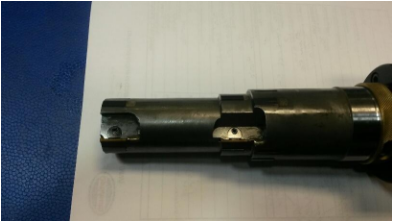What was the situation? (Market Segment, Application, Machine/Equipment, Materials, Tooling, Filtration, Services etc)
An Aerospace Component Manufacturer in the South East of England supplies many different parts as single or assembled units to the main Aerospace OEM’s. The manufacturer has a number of CNC Machining centres some with FMS capability to produce high precision, high quality electronic components using a high end competitors coolant utilising demineralised water for making up the emulsion.
What was the problem? (Explain the problem and where possible the process in determining the root cause to the problem)
The existing coolant was giving rise to component quality issues which in turn transposed to low tool life on their Cast Stainless (S80) Dowel Assembly Housing particularly on their combination Mapal reaming tool where high lubricity is required to maintain the surface finish. Concentrations at times had increased to 12% to obtain the required component quality and tool life. There were machine operators having skin complaints and longevity was a concern in not reaching the expected 12 month service life (normally 6 – 9 months) with all machines also having fungus contamination. It was also observed that tooling holders (DIN Taper) and sockets had showed signs of corrosion which is probably as a result of bacteria infested coolant. Coolant controls were provided by the supplier and by the machine tool operator and thought to be satisfactory.
What was the solution? (Details of our proposal or recommendation)
After reviewing the process Bonderite L-MR 21972 was recommended at target concentration of 7% which has the highest lubrication properties of all Henkel’s water based cutting fluids but also maintaining its unique biostatic control for both bacteria and fungal resistance. Bonderite L-MR 21972 also produces a very stable micro-fine emulsion that wets the surface extremely well to aid cleaning, penetration of the fluid between the swarf chip and the tool face and as the case for the Mapal reaming tool, between the bore and burnishing pads resulting in lower friction and tool wear even at modest pump pressures (30 – 40 Bar).
How was the solution Implemented? (Include what we did as a service to the customer)
Before the trial, baseline data was obtained regarding the performance of the competitors product – the data taken was stated as ‘typical’ of the fluids performance over its time in service.
A Makino A66 Machining Centre was thoroughly cleaned out using system cleaner and where possible the fungal masses were removed from the coolant tank, drag conveyor and machine areas. The machine was filled at 8% using town’s main water (circa 15 dh) to prevent foaming conditions with high pressure coolant for through spindle coolant at 30 – 40 Bar. All top ups are made thereafter with demineralised water to maintain the de-foam characteristics and prevent out of control conditions on corrosion caused by hard water salt build up.
How did the Customer benefit? (Quantify savings in OEE, maintenance & repair, people, indirect materials & improvements in HSE etc)
The combination Mapal reaming tool (Fig. 1) was highlighted as it is the most critical operation in this machining process for the optical bore (Fig. 2) which has 3 concentric bores to machine.
Fig. 1 – Mapal Combination Reaming Tool

Machine Data:
Machine: Makino A66 Machining Centre
Mapal Reaming Diameters: 49, 43, 38 mm Dia.
Cutting Tool Type: TiN Coated Inserts
RPM: 300
Tool Feed: 30mm/min (0.1mm/rev)
Coolant System: FSE with Drag Conveyor, Rotary Drum and Duplex Cartridge Filters
System Capacity: 1800 Ltrs
Coolant Pressure: 30 – 40 Bar
Air Extraction System: Filtermist
Water Quality: 15 dh for Fill, 1 dH for top ups
Tool Life on the ‘Finishing’ Mapal Reamer tool increased from 40 minutes to 280 minutes. The power draw at the spindle during this cutting operation reduced threefold from 15 Amps down to 5 Amps. Dimensional accuracy on the (Mapal) 38 mm x 60 mm bore increased considerably with the component specification of 0.016 mm with 0.005 mm being achieved. Surface finish also improved from a specification of 1.6um Ra with 0.82 um Ra being achieved consistently. Hole concentricity between the 3 bores has also improved considerably. Previous product rarely achieved these results or as consistently. Bonderite L-MR 21972 is operating at least 4% reduction in concentration meaning a 25% saving in product usage and the system life is expected to be at least 12 months should the controls and any contamination be managed therefore savings in waste disposal will also be realised.
What was the conclusion?
The customer is delighted with the performance and economic value that Bonderite L-MR 21972 has returned. A programme is now under way to replace all machines currently running on the previous product in the ‘difficult to machine’ areas with Bonderite L-MR 21972.
